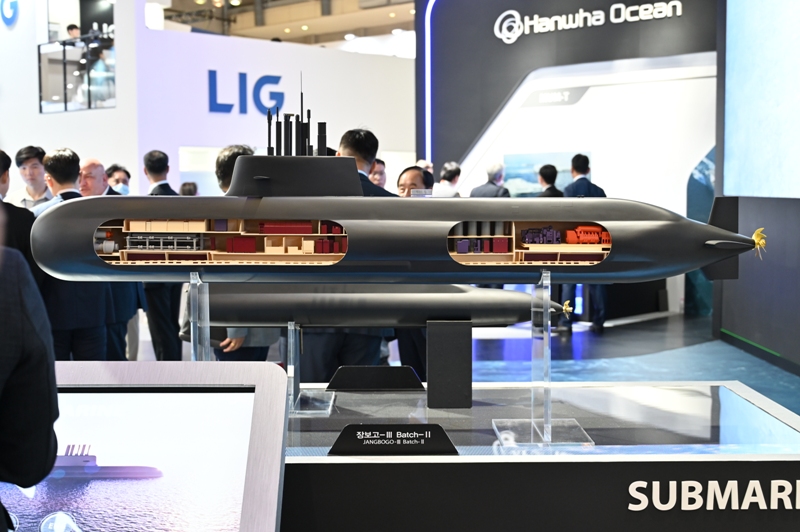
Embarking on the Future: Hanhwa Ocean Unveils New Technology-Driven KSS-III (Jangbogo-III) Class Submarines
A military and maritime equipment exhibition titled ‘MADEX 2023’ was held for 3 days at BEXCO in Busan, South Korea starting on June 7th. During the showcase of various military equipment, the Hanwha Group introduced the technology behind three submarines that have been newly developed under Hanwha Ocean. While two of their three existing KSS-III (Jangbogo-III) Class Batch-I submarines are already in use by R.O.K.N, during the event they revealed a new and improved fleet of 3,000-ton export submarines that are garnering interest in various ways.
The next-generation KSS-III Batch-II submarines are elongated versions of KSS-II with additional vertical launchers. However, the main difference between the previous version and the newly revealed KSS-III Batch-II submarines is their battery technology; while the previous submarines function with a standard battery system, the new KSS-III Batch-II submarines are diesel-electric vessels that operate with lithium-ion batteries reminiscent of those found in electric vehicles. Furthermore, these new batteries are half the size of their predecessors offering more efficiency and a larger energy capacity while being more economical overall. The main reason for this change was to develop lighter-weight batteries with a higher capacity.
One of the most significant changes is the generator, as higher charging power is required to minimize the increased battery charging time due to the increased battery capacity of the lithium-ion battery. As a result, the Batch-II submarines will be fitted with the latest MTU 4000 generator, as opposed to the Batch-I submarines which were fitted with the soon to be discontinued MTU 396 generators. And also Hanwha has also increased charging efficiency splitting the batteries into two groups, meaning that as one is charging, the other can provide power. The lithium-ion batteries are made of two groups consisting of multiple trays which respectively contain multiple models; this dual system means it is easy to monitor the exact amount of energy left and how long the submarine can run. Furthermore, Hanwha has already expressed their hope to develop solid lithium-ion battery systems in future submarines.

In terms of the charging system for these batteries, they make electricity and usable water through a fuel-cell system called AIP (Air Independent Propulsion). This system means that the submarines no longer need to return to the open air as frequently to charge: these submarines can stay underwater for more than 5 times longer compared to submarine without AIP, far surpassing the limitations of the Batch-I submarines. Additionally, the Batch-II submarines are the first diesel-electric submarines ever to be capable of launching submarine-launched ballistic missiles (SLBMs).
Another important fact is that, as the submarine is elongated, all the systems inside of submarine to be increased its capacity so that generated noise level is increased. However, Hanwha has also taken this into account and has plans to include elastic platforms to absorb sound vibrations within the body of the submarine, effectively dampening the additional noise pollution. Though they are still under construction, it is believed that the Batch-II submarines will actually be quieter than the Batch-I submarines.
Batteries aren’t the only significant difference between the two new fleets – in acknowledgment of the growing presence of female crew, the KSS-III Batch-II submarines are also fitted with designated female crew cabins to align with the gender equality trend of R.O.K.N. As they provide more accommodations within the submarines for the evolving face of the crew, the Batch-II submarines are already being praised as “gender-balanced.”
Finally, the new submarines are fitted with improved systems for missile launching, security, and sonar. Particularly in the case of the sonar, the newly developed system can gather a wealth of more precise information and offer a much higher level of accuracy. Likewise, with the addition of vertical launchers, there will be an increase in the missile firing capability of the submarines.
During the MADEX event, Hanwha Ocean also revealed they have begun a preliminary study on the feasibility of developing a ‘Ghost Commander Ship’. The expected function of this device would be to give the Korean Navy the ability to operate multiple manned and unmanned systems such as USVs, UUVs, and UAVs remotely by the end of the 2030s, and the Korean Navy are expected to begin their own internal tests within the next year.
This comes shortly after Hanwha Ocean’s recent development of the 50-ton combat UUV whose concept design was revealed to the Korean Navy late last year. Though the details of the device are confidential, it is known that the hull will be fabricated with lightweight materials that have low magnetic signatures and reduced noise production underwater, resulting in low discoverability on enemy radar.
Capability-wise, the aim is that the Ghost Commander Ship will operate on a fully integrated electric propulsion system with energy stores that would allow the addition of high-energy laser weapons and sensors to the vessel. Furthermore, through the implementation of new technologies, the ship would have advanced cyber security and control capabilities for managing unmanned vessels through the use of low earth orbit-satellite systems.
At present the new KSS-III (Jangbogo-III) Class Batch-II submarines are still under construction with the first two intended to be delivered in the next 3 years, and, likely, these will also be utilized by R.O.K.N in the future to aid in the security of South Korea.

Comments are closed.